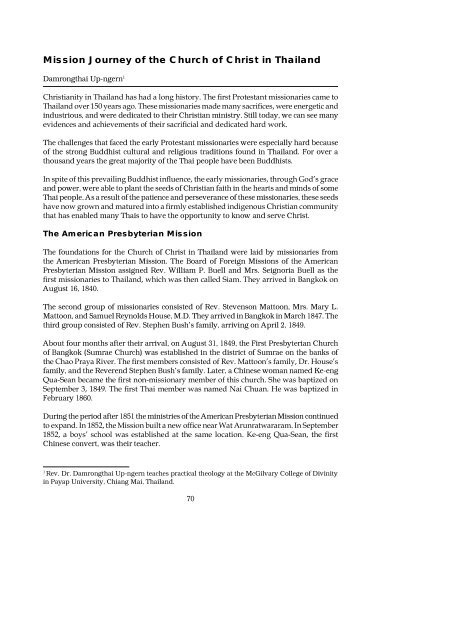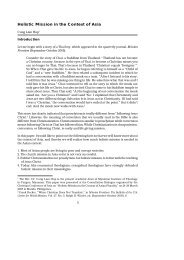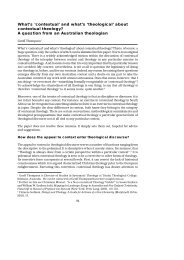Mission Journey of the Church of Christ in Thailand
Mission Journey of the Church of Christ in Thailand
Mission Journey of the Church of Christ in Thailand
You also want an ePaper? Increase the reach of your titles
YUMPU automatically turns print PDFs into web optimized ePapers that Google loves.
<strong>Mission</strong> <strong>Journey</strong> <strong>of</strong> <strong>the</strong> <strong>Church</strong> <strong>of</strong> <strong>Christ</strong> <strong>in</strong> <strong>Thailand</strong><br />
Damrongthai Up-ngern 1<br />
<strong>Christ</strong>ianity <strong>in</strong> <strong>Thailand</strong> has had a long history. The � rst Protestant missionaries came to<br />
<strong>Thailand</strong> over 150 years ago. These missionaries made many sacri� ces, were energetic and<br />
<strong>in</strong>dustrious, and were dedicated to <strong>the</strong>ir <strong>Christ</strong>ian m<strong>in</strong>istry. Still today, we can see many<br />
evidences and achievements <strong>of</strong> <strong>the</strong>ir sacri� cial and dedicated hard work.<br />
The challenges that faced <strong>the</strong> early Protestant missionaries were especially hard because<br />
<strong>of</strong> <strong>the</strong> strong Buddhist cultural and religious traditions found <strong>in</strong> <strong>Thailand</strong>. For over a<br />
thousand years <strong>the</strong> great majority <strong>of</strong> <strong>the</strong> Thai people have been Buddhists.<br />
In spite <strong>of</strong> this prevail<strong>in</strong>g Buddhist <strong>in</strong>� uence, <strong>the</strong> early missionaries, through God’s grace<br />
and power, were able to plant <strong>the</strong> seeds <strong>of</strong> <strong>Christ</strong>ian faith <strong>in</strong> <strong>the</strong> hearts and m<strong>in</strong>ds <strong>of</strong> some<br />
Thai people. As a result <strong>of</strong> <strong>the</strong> patience and perseverance <strong>of</strong> <strong>the</strong>se missionaries, <strong>the</strong>se seeds<br />
have now grown and matured <strong>in</strong>to a � rmly established <strong>in</strong>digenous <strong>Christ</strong>ian community<br />
that has enabled many Thais to have <strong>the</strong> opportunity to know and serve <strong>Christ</strong>.<br />
The American Presbyterian <strong>Mission</strong><br />
The foundations for <strong>the</strong> <strong>Church</strong> <strong>of</strong> <strong>Christ</strong> <strong>in</strong> <strong>Thailand</strong> were laid by missionaries from<br />
<strong>the</strong> American Presbyterian <strong>Mission</strong>. The Board <strong>of</strong> Foreign <strong>Mission</strong>s <strong>of</strong> <strong>the</strong> American<br />
Presbyterian <strong>Mission</strong> assigned Rev. William P. Buell and Mrs. Seignoria Buell as <strong>the</strong><br />
� rst missionaries to <strong>Thailand</strong>, which was <strong>the</strong>n called Siam. They arrived <strong>in</strong> Bangkok on<br />
August 16, 1840.<br />
The second group <strong>of</strong> missionaries consisted <strong>of</strong> Rev. Stevenson Mattoon, Mrs. Mary L.<br />
Mattoon, and Samuel Reynolds House, M.D. They arrived <strong>in</strong> Bangkok <strong>in</strong> March 1847. The<br />
third group consisted <strong>of</strong> Rev. Stephen Bush’s family, arriv<strong>in</strong>g on April 2, 1849.<br />
About four months after <strong>the</strong>ir arrival, on August 31, 1849, <strong>the</strong> First Presbyterian <strong>Church</strong><br />
<strong>of</strong> Bangkok (Sumrae <strong>Church</strong>) was established <strong>in</strong> <strong>the</strong> district <strong>of</strong> Sumrae on <strong>the</strong> banks <strong>of</strong><br />
<strong>the</strong> Chao Praya River. The � rst members consisted <strong>of</strong> Rev. Mattoon’s family, Dr. House’s<br />
family, and <strong>the</strong> Reverend Stephen Bush’s family. Later, a Ch<strong>in</strong>ese woman named Ke-eng<br />
Qua-Sean became <strong>the</strong> � rst non-missionary member <strong>of</strong> this church. She was baptized on<br />
September 3, 1849. The � rst Thai member was named Nai Chuan. He was baptized <strong>in</strong><br />
February 1860.<br />
Dur<strong>in</strong>g <strong>the</strong> period after 1851 <strong>the</strong> m<strong>in</strong>istries <strong>of</strong> <strong>the</strong> American Presbyterian <strong>Mission</strong> cont<strong>in</strong>ued<br />
to expand. In 1852, <strong>the</strong> <strong>Mission</strong> built a new <strong>of</strong>� ce near Wat Arunratwararam. In September<br />
1852, a boys’ school was established at <strong>the</strong> same location. Ke-eng Qua-Sean, <strong>the</strong> � rst<br />
Ch<strong>in</strong>ese convert, was <strong>the</strong>ir teacher.<br />
1 Rev. Dr. Damrongthai Up-ngern teaches practical <strong>the</strong>ology at <strong>the</strong> McGilvary College <strong>of</strong> Div<strong>in</strong>ity<br />
<strong>in</strong> Payap University, Chiang Mai, <strong>Thailand</strong>.<br />
70
Four years later, <strong>the</strong> Presbyterian <strong>Mission</strong> bought additional property at Sumrae. They<br />
<strong>the</strong>n moved <strong>the</strong> <strong>Mission</strong> Of� ce and <strong>the</strong> boys’ school to this new location. In 1888, Rev.<br />
John A. Egg<strong>in</strong>s started a new boys’ school <strong>in</strong> Thonburi. The earlier boys’ school that had<br />
been near Wat Arunratwararam was now united with this new boys’ school. This new<br />
comb<strong>in</strong>ed school would later become <strong>the</strong> Bangkok <strong>Christ</strong>ian College. Dur<strong>in</strong>g this <strong>in</strong>itial<br />
period <strong>the</strong> ma<strong>in</strong> purposes <strong>of</strong> <strong>the</strong> American Presbyterian <strong>Mission</strong> <strong>in</strong> Siam (<strong>Thailand</strong>) were:<br />
Evangelism (shar<strong>in</strong>g <strong>the</strong> gospel with <strong>the</strong> Thai people); Education (teach<strong>in</strong>g Thai young<br />
people basic read<strong>in</strong>g, writ<strong>in</strong>g, and ma<strong>the</strong>matical skills as well as English language and<br />
about <strong>the</strong> <strong>Christ</strong>ian faith); and Medical Care (heal<strong>in</strong>g and m<strong>in</strong>ister<strong>in</strong>g to <strong>the</strong> sick among<br />
<strong>the</strong> Thai people).<br />
The Presbytery <strong>of</strong> <strong>the</strong> Siam <strong>Mission</strong><br />
On 20 June 1858, Rev. Dr. Daniel McGilvary, Rev. Jonathan Wilson, and Mrs. Mary Wilk<strong>in</strong><br />
Wilson arrived <strong>in</strong> Bangkok. Shortly afterwards, <strong>the</strong> Presbytery <strong>of</strong> <strong>the</strong> Siam <strong>Mission</strong> was<br />
founded <strong>in</strong> Bangkok. Dur<strong>in</strong>g <strong>the</strong> follow<strong>in</strong>g years, <strong>the</strong> Presbytery <strong>of</strong> <strong>the</strong> Siam <strong>Mission</strong> had<br />
more missionaries and resources, and was able to expand its m<strong>in</strong>istries <strong>in</strong>to o<strong>the</strong>r parts<br />
<strong>of</strong> <strong>Thailand</strong>.<br />
Although <strong>the</strong> responsibility <strong>of</strong> <strong>the</strong> Presbytery <strong>of</strong> Siam <strong>Mission</strong> was to start m<strong>in</strong>istries <strong>in</strong> <strong>the</strong><br />
central and sou<strong>the</strong>rn regions <strong>of</strong> <strong>Thailand</strong>, most <strong>of</strong> <strong>the</strong>ir achievements occurred <strong>in</strong> central<br />
<strong>Thailand</strong>, especially <strong>in</strong> and around Bangkok. For example, <strong>in</strong> <strong>the</strong> � eld <strong>of</strong> education <strong>the</strong><br />
Presbytery opened many well known schools for boys and girls <strong>in</strong> Bangkok. In 1874 <strong>the</strong>y<br />
opened Wattana Wittayalai School for girls. Three years later <strong>the</strong> Jane Hay’s Memorial<br />
School for girls was also opened. In 1890 <strong>the</strong> Bangkok <strong>Christ</strong>ian High School for boys<br />
was begun.<br />
Several churches were also established. These were <strong>the</strong> Suabsampanthawong <strong>Church</strong>,<br />
established <strong>in</strong> 1904, <strong>the</strong> Wattana <strong>Church</strong> next to <strong>the</strong> Wattana Wittayalai School <strong>in</strong> 1922,<br />
and a Ch<strong>in</strong>ese <strong>Church</strong> (Yellow Bridge <strong>Church</strong>) at Ratchawong Road <strong>in</strong> 1932.<br />
Outside Bangkok, <strong>the</strong> Presbytery opened a <strong>Mission</strong> Station <strong>in</strong> Phetchaburi <strong>in</strong> 1861. A few<br />
years later <strong>the</strong>y established Sripimontum <strong>Church</strong> and Arunpradit School <strong>in</strong> Phetchaburi.<br />
In 1872 <strong>Christ</strong>ian work was begun <strong>in</strong> Ayuthtaya <strong>in</strong> <strong>the</strong> central area. In 1899 this work was<br />
expanded to Pitsanulok. In 1900 work was begun <strong>in</strong> Nakorn-Sritummarat <strong>in</strong> <strong>the</strong> south,<br />
and <strong>in</strong> 1910 this work was expanded to Trang.<br />
In 1867, at <strong>the</strong> General Meet<strong>in</strong>g <strong>of</strong> <strong>the</strong> Presbytery <strong>of</strong> Siam, Nai Klai was appo<strong>in</strong>ted to be<br />
<strong>the</strong> � rst Thai <strong>Christ</strong>ian lay preacher.<br />
The Presbytery <strong>of</strong> Lao <strong>Mission</strong><br />
At that time, <strong>the</strong> people liv<strong>in</strong>g <strong>in</strong> nor<strong>the</strong>astern and nor<strong>the</strong>rn <strong>Thailand</strong> were called <strong>the</strong><br />
“Lao”. There were some important differences between those liv<strong>in</strong>g <strong>in</strong> <strong>the</strong> central region<br />
(Siam) and those liv<strong>in</strong>g <strong>in</strong> <strong>the</strong> north (Lao). These differences <strong>in</strong>cluded cultural and political<br />
history, everyday customs, and languages. Chiang Mai and many o<strong>the</strong>r cities <strong>in</strong> <strong>the</strong> North<br />
<strong>of</strong> <strong>Thailand</strong> had been <strong>in</strong>dependent states before be<strong>in</strong>g taken over by Siam.<br />
71
In December 1860 <strong>the</strong> Rev. Dr. Daniel McGilvary met <strong>the</strong> <strong>the</strong>n governor <strong>of</strong> Chiang Mai,<br />
Chao Kawirorot, and his family <strong>in</strong> Bangkok. They were <strong>in</strong>terested <strong>in</strong> <strong>the</strong> missionaries’<br />
activities and <strong>in</strong> <strong>the</strong> new western technologies that <strong>the</strong>y were <strong>in</strong>troduc<strong>in</strong>g <strong>in</strong>to <strong>the</strong> country.<br />
McGilvary immediately saw an opportunity to evangelize and spread <strong>the</strong> gospel among<br />
<strong>the</strong> Lao people.<br />
In 1867 Rev. Dr. Daniel McGilvary started <strong>the</strong> � rst <strong>Christ</strong>ian mission <strong>in</strong> nor<strong>the</strong>rn <strong>Thailand</strong><br />
<strong>in</strong> <strong>the</strong> city <strong>of</strong> Chiang Mai. The new <strong>Christ</strong>ian work <strong>in</strong> <strong>the</strong> north <strong>of</strong> <strong>Thailand</strong> was called <strong>the</strong><br />
“Lao <strong>Mission</strong>”. After only a short time, <strong>the</strong> � rst nor<strong>the</strong>rn Thai converted and became a<br />
<strong>Christ</strong>ian. His name was Nai Nan Inta, and he was baptized on January 3, 1869. Later on<br />
<strong>in</strong> April 1875, he was elected as an Elder <strong>in</strong> <strong>the</strong> Chiang Mai church.<br />
Almost everywhere <strong>in</strong> <strong>the</strong> world where <strong>the</strong> gospel has been preached, <strong>Christ</strong>ians have<br />
been <strong>the</strong> object <strong>of</strong> persecution. <strong>Thailand</strong> is no exception. In Nor<strong>the</strong>rn <strong>Thailand</strong>, Noi Sunya<br />
(Suriya) and Nan Chai, two early converts to <strong>the</strong> <strong>Christ</strong>ian faith, lost <strong>the</strong>ir lives as a direct<br />
consequence <strong>of</strong> <strong>the</strong>ir conversion to <strong>Christ</strong>ianity. On Tuesday morn<strong>in</strong>g, September 14, 1869<br />
<strong>the</strong> two martyrs were executed by order <strong>of</strong> <strong>the</strong> ruler <strong>of</strong> Chiang Mai.<br />
The reason given by <strong>the</strong> ruler for <strong>the</strong> execution was <strong>the</strong> refusal <strong>of</strong> <strong>the</strong> two new <strong>Christ</strong>ians,<br />
who were <strong>in</strong> his employ, to work on <strong>the</strong> Sabbath. They were charged with disobedience<br />
and sentenced to be beaten to death because <strong>of</strong> <strong>the</strong>ir refusal to do <strong>the</strong> ruler’s work.<br />
Actually, <strong>the</strong> ruler <strong>of</strong> Chiang-Mai was under <strong>in</strong>creas<strong>in</strong>g political and social pressures,<br />
and he blamed <strong>the</strong> <strong>Christ</strong>ians’ presence for his dif� culties <strong>in</strong> rul<strong>in</strong>g. So, he had decided<br />
to punish <strong>the</strong>se two <strong>Christ</strong>ians as a way to discourage o<strong>the</strong>rs. Later, challenged publicly<br />
by Rev. Dr. McGilvary, Pr<strong>in</strong>ce Kawilorot openly acknowledged that <strong>the</strong> only reason <strong>the</strong><br />
two men had been killed was because <strong>the</strong>y were <strong>Christ</strong>ians.<br />
In July 1880 a new church was established <strong>in</strong> <strong>the</strong> district <strong>of</strong> Sarapee by Dr. McGilvary. The<br />
new church was named <strong>the</strong> Bethlehem <strong>Church</strong>. On <strong>Christ</strong>mas Day, December 25, 1880,<br />
ano<strong>the</strong>r new church was started <strong>in</strong> <strong>the</strong> Doisaket District. This new church was called <strong>the</strong><br />
Mae Dok Deang <strong>Church</strong>. In 1889 a Theological Tra<strong>in</strong><strong>in</strong>g Center was opened <strong>in</strong> Chiang<br />
Mai. This center would eventually evolve <strong>in</strong>to what is today <strong>the</strong> McGilvary College <strong>of</strong><br />
Div<strong>in</strong>ity at Payap University.<br />
In 1875 Mrs. Sophie McGilvary, <strong>the</strong> wife <strong>of</strong> Daniel McGilvary, started to teach Thai girls <strong>in</strong><br />
her home <strong>in</strong> Chiang Mai. Later, Miss Mary Campbell and Miss Edna Cole jo<strong>in</strong>tly founded<br />
a girls’ school <strong>in</strong> <strong>the</strong> city. They developed <strong>the</strong> curriculum for <strong>the</strong> school and supervised its<br />
operation. This school later became known as Dara Academy. A few years later, <strong>in</strong> 1888,<br />
a school for boys was opened under <strong>the</strong> direction <strong>of</strong> Rev. David G. Coll<strong>in</strong>s. This school<br />
would later be known as <strong>the</strong> Pr<strong>in</strong>ce Royal’s College.<br />
In 1885, <strong>the</strong> Presbytery <strong>of</strong> Laos <strong>Mission</strong> expanded its m<strong>in</strong>istries to Lampang. In 1891 <strong>the</strong><br />
<strong>Mission</strong> started two girls’ schools, which were later to be known as Kennett McKeanse<br />
School and Witchanaree School. In 1896 a mission hospital, later to be known as<br />
Vansanwood Hospital, was opened by <strong>the</strong> <strong>Mission</strong>. In 1891, <strong>the</strong> <strong>Mission</strong> expanded to<br />
Lamphun. There <strong>the</strong>y were able to establish three churches. These three churches were<br />
<strong>the</strong> Be<strong>the</strong>l <strong>Church</strong>, <strong>the</strong> Wang moon <strong>Church</strong>, and <strong>the</strong> Lamphun <strong>Church</strong>.<br />
72
In 1893 <strong>the</strong> <strong>Mission</strong> expanded its m<strong>in</strong>istries to Phrae. In 1914 <strong>the</strong> Ban Papeung <strong>Church</strong><br />
<strong>in</strong> Phrae was begun, and later churchs were established at both Ban Dan and Ban Houay<br />
Rai. By 1897 <strong>the</strong> <strong>Mission</strong> had expanded its work to Chiang Rai. In 1910 Dr. William A.<br />
Bricks, M.D., began to give medical care to <strong>the</strong> people <strong>of</strong> Chiang Rai. He soon opened a<br />
mission hospital that would later be called Overbrook Hospital.<br />
In 1887 Dr. A. M. Cary, M.D., started a temporary hospital to care for those af� icted with<br />
leprosy at Ban Pakouy Village near <strong>the</strong> city <strong>of</strong> Chiang Mai. A few years later <strong>in</strong> 1890 Dr.<br />
James W. McKean took over <strong>the</strong> management <strong>of</strong> this hospital. McKean <strong>the</strong>n opened a<br />
permanent hospital as a part <strong>of</strong> <strong>the</strong> <strong>Mission</strong> Station. This facility was later named <strong>the</strong><br />
McKean Hospital. The medical care given by this hospital was one <strong>of</strong> <strong>the</strong> most important<br />
m<strong>in</strong>istries that attracted people to convert to <strong>Christ</strong>ianity.<br />
In 1892 while Reverend Daniel McGilvary was on an elephant ride with his daughter<br />
Cornelia, he met a group <strong>of</strong> Lahu tribal people who lived near Wiang Papao. (Travel by<br />
elephant was <strong>the</strong> most convenient way to travel <strong>in</strong> nor<strong>the</strong>rn <strong>Thailand</strong> at that time.) The<br />
Lahu were <strong>in</strong>terested <strong>in</strong> know<strong>in</strong>g about <strong>the</strong> <strong>Christ</strong>ian faith, and McGilvary taught <strong>the</strong>m <strong>the</strong><br />
word <strong>of</strong> God. They converted to <strong>Christ</strong>ianity. The Lahu <strong>Christ</strong>ians <strong>the</strong>n built a chapel <strong>in</strong><br />
one <strong>of</strong> <strong>the</strong>ir villages, and <strong>the</strong>y cont<strong>in</strong>ued to come toge<strong>the</strong>r to worship <strong>the</strong>re on Sundays.<br />
Reflection and Recommendation<br />
On <strong>the</strong> basis <strong>of</strong> this case study, I would now like to <strong>of</strong>fer <strong>the</strong> follow<strong>in</strong>g recommendations<br />
and re� ection.<br />
Over <strong>the</strong> years <strong>the</strong> Thai <strong>Church</strong> has encountered a lot <strong>of</strong> problems. Until today <strong>the</strong> Thai<br />
church sometimes needs help from abroad and is not always ready to take complete<br />
responsibility for all its m<strong>in</strong>istries. None<strong>the</strong>less, today, Thai <strong>Christ</strong>ians are responsible<br />
for <strong>the</strong>ir own churches’ m<strong>in</strong>istries without hav<strong>in</strong>g to depend on resources or � nancial<br />
support from foreign countries.<br />
In <strong>the</strong> past it was always taken for granted that after Thai churches were established, <strong>the</strong><br />
Thai members <strong>of</strong> <strong>the</strong> new congregations would be responsible for <strong>the</strong>ir church’s m<strong>in</strong>istries.<br />
The missionaries who had established <strong>the</strong> new church always stayed at <strong>the</strong> <strong>Mission</strong> Station.<br />
So, churches were not <strong>of</strong>ten visited by missionaries. As a result, <strong>the</strong> adm<strong>in</strong>istration <strong>of</strong><br />
many congregations was less than ideal.<br />
Also, <strong>the</strong> schools, hospitals, and o<strong>the</strong>r m<strong>in</strong>isterial organizations established by <strong>the</strong><br />
missionaries cont<strong>in</strong>ued to require much attention and many resources <strong>in</strong> order to<br />
operate properly at a high level <strong>of</strong> ef� ciency. Once <strong>the</strong> Thai church was established as an<br />
<strong>in</strong>dependent entity, <strong>the</strong> leadership and responsibility for <strong>the</strong>se <strong>in</strong>stitutions and <strong>the</strong>ir work<br />
passed from <strong>the</strong> missionaries to <strong>the</strong> local Thai <strong>Christ</strong>ians. Often <strong>the</strong>y were <strong>in</strong>itially unable<br />
to meet <strong>the</strong> challenge <strong>of</strong> cont<strong>in</strong>u<strong>in</strong>g <strong>the</strong> <strong>of</strong>ten excellent work done by <strong>the</strong> missionaries. As a<br />
result, <strong>the</strong> adm<strong>in</strong>istration <strong>of</strong> many <strong>of</strong> <strong>the</strong> <strong>Christ</strong>ian <strong>in</strong>stitutions was also less than ideal.<br />
Start<strong>in</strong>g <strong>in</strong> 1895 <strong>the</strong> Board <strong>of</strong> Foreign <strong>Mission</strong>s <strong>of</strong> <strong>the</strong> American Presbyterian <strong>Mission</strong> tried<br />
to develop <strong>the</strong> idea that <strong>the</strong> Thai <strong>Christ</strong>ians should support <strong>the</strong>ir own church m<strong>in</strong>istries by<br />
73
<strong>the</strong>mselves. The Board issued methods and guidel<strong>in</strong>es for missionary and local churches<br />
to practice. However, due to lack <strong>of</strong> tra<strong>in</strong><strong>in</strong>g, <strong>of</strong>ten <strong>the</strong> churches could not follow <strong>the</strong>se<br />
methods and guidel<strong>in</strong>es.<br />
Early missionary reports <strong>in</strong>dicated that Thai pastors, elders, deacons and church members<br />
<strong>of</strong>ten could not perform <strong>the</strong>ir m<strong>in</strong>istries by <strong>the</strong>mselves. They did not understand how to<br />
adm<strong>in</strong>ister church affairs or even how to lead <strong>the</strong> meet<strong>in</strong>gs. They needed tra<strong>in</strong><strong>in</strong>g to be<br />
effective as evangelists, pastors, preachers, and church leaders.<br />
In 1893 <strong>the</strong> American Presbyterian <strong>Mission</strong> Board expanded on <strong>the</strong> “Nevius Plan” <strong>in</strong>to <strong>the</strong><br />
Thai <strong>Church</strong>. But later <strong>in</strong> 1895 <strong>the</strong>re were reports <strong>of</strong> <strong>in</strong>effectiveness <strong>in</strong> local churches. This<br />
was a result <strong>of</strong> local churches not understand<strong>in</strong>g <strong>the</strong> role <strong>of</strong> a pastor sent to <strong>the</strong> church.<br />
Also, <strong>the</strong>y did not understand why <strong>the</strong>y had to pay his salary. Some church members<br />
refused to meet <strong>the</strong>ir � nancial obligations and did not contribute to pay<strong>in</strong>g <strong>the</strong> salary <strong>of</strong><br />
<strong>the</strong>ir pastors. So <strong>the</strong> plan did not really work.<br />
Some missionaries believed that <strong>in</strong> Thai culture, <strong>the</strong> Elder system was appropriate. They<br />
believed that <strong>the</strong> idea that local churches should have <strong>the</strong>ir own pastors came from<br />
<strong>the</strong> missionaries <strong>the</strong>mselves ra<strong>the</strong>r than from <strong>the</strong> desires and needs <strong>of</strong> <strong>the</strong> Thai church<br />
members. Therefore, <strong>the</strong> missionaries tended to leave <strong>the</strong> responsibility for <strong>the</strong> local<br />
churches <strong>in</strong> <strong>the</strong> hands <strong>of</strong> <strong>the</strong> local lay members, and those churches that had no pastors<br />
cont<strong>in</strong>ued to use <strong>the</strong> laity to preach and to perform <strong>the</strong> various m<strong>in</strong>istries <strong>of</strong> <strong>the</strong> church.<br />
Most missionaries believed that Thai culture was a dark culture, depend<strong>in</strong>g on <strong>the</strong><br />
idolatrous religion and that Thai people needed to be converted to <strong>Christ</strong>ianity. Therefore,<br />
missionaries should be sensitive to religions and cultural plurality <strong>in</strong> <strong>Thailand</strong>.<br />
The ma<strong>in</strong> purposes <strong>of</strong> <strong>the</strong> American Presbyterian <strong>Mission</strong> <strong>in</strong> Siam (<strong>Thailand</strong>) were:<br />
Evangelism (shar<strong>in</strong>g <strong>the</strong> gospel with <strong>the</strong> Thai people); Education (teach<strong>in</strong>g Thai young<br />
people basic read<strong>in</strong>g, writ<strong>in</strong>g, and ma<strong>the</strong>matical skills as well as English language and<br />
about <strong>the</strong> <strong>Christ</strong>ian faith); Medical Care (heal<strong>in</strong>g and m<strong>in</strong>ister<strong>in</strong>g to <strong>the</strong> sick among <strong>the</strong><br />
Thai people). Jesus’ mission was a holistic mission. <strong>Mission</strong>aries should attend to <strong>the</strong> total<br />
needs <strong>of</strong> <strong>the</strong> people ra<strong>the</strong>r than only for evangelism (spiritual salvation), education and<br />
medical care.<br />
Bibliography<br />
Maclean, Josepheen. Some Sources and Roots <strong>of</strong> <strong>the</strong> <strong>Church</strong> <strong>of</strong> <strong>Christ</strong> <strong>in</strong> <strong>Thailand</strong>. Payap<br />
University Archives, March 1987, No.3<br />
Pongudom, Prasit. The History <strong>of</strong> The <strong>Church</strong> <strong>of</strong> <strong>Christ</strong> <strong>in</strong> <strong>Thailand</strong>. Bangkok: Chounpim<br />
Publisher, 1984.<br />
Sangshay, Chamnan, ed. 70 Years <strong>of</strong> Bless<strong>in</strong>gs: The <strong>Church</strong> <strong>of</strong> <strong>Christ</strong> <strong>in</strong> <strong>Thailand</strong>. Bangkok:<br />
74




